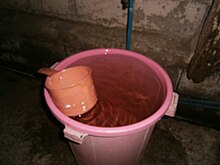The examples and perspective in this article may not represent a worldwide view of the subject. (October 2021) |

The tabò (Tagalog pronunciation: [ˈtaːbɔʔ]) is the traditional hygiene tool primarily for cleansing, bathing, and cleaning the floor of the bathroom in the Philippines, Indonesia, East Timor, Malaysia, Vietnam and Brunei. Tabò is the Filipino name, while gayung and cebok (pronounced chabo') are the equivalent terms used in Indonesia, Brunei, Malaysia, and East Timor.[1] Its Vietnamese name is thau tắm or chậu nước. The tabò could most commonly be in found rural areas though it is also widely used in cities. The word may be related to the word cebok in Indonesia and Malaysia, which describes the process of cleansing oneself using a tabò (or cebok) in a mandi (another Bahasa phrase for the tabò is kamar mandi).
The tabò can sometimes be translated into English as a "dipper" or "pitcher", but according to Michael Tan, chancellor at the University of the Philippines-Diliman and a columnist at the Philippine Daily Inquirer, tabò is much more than a dipper.[2] The plastic tabò is an almost indispensable fixture in the Filipino home. Filipinos living overseas will bring their own tabò or even ask their relatives to send one over if they forget.
Tabò is also widely used anywhere in a household for purposes other than bathing, such as for measuring volume. 1 tabò is often equal to 1 liter, as usually the household tabò would be the used plastic container of 1 liter of motor oil.
A tabò has similarity in design and use to the hishaku (柄杓), a Japanese water dipper with a handle made of bamboo.
- ^ Malasig, Jeline (2018-11-07). "A foreign blogger's fascination with the 'coolest Filipino household item'". Interaksyon. Archived from the original on 2018-11-10. Retrieved 2018-11-10.
- ^ Tan, Michael L. (May 24, 2011). "'Tabo' culture". Philippine Daily Inquirer. Archived from the original on July 16, 2014. Retrieved July 28, 2014.
